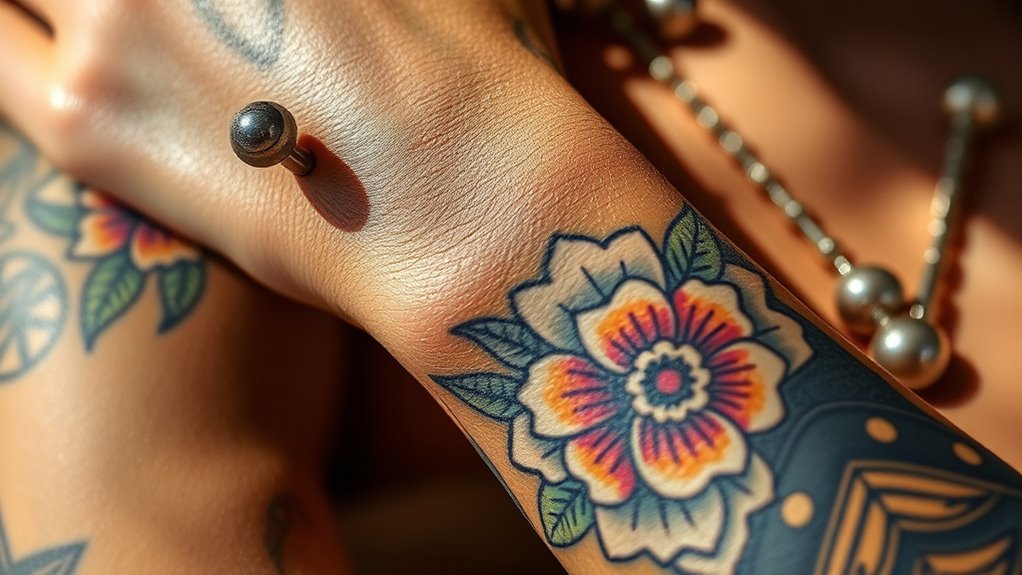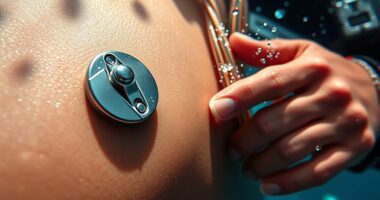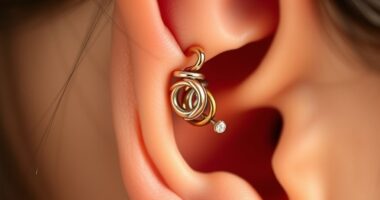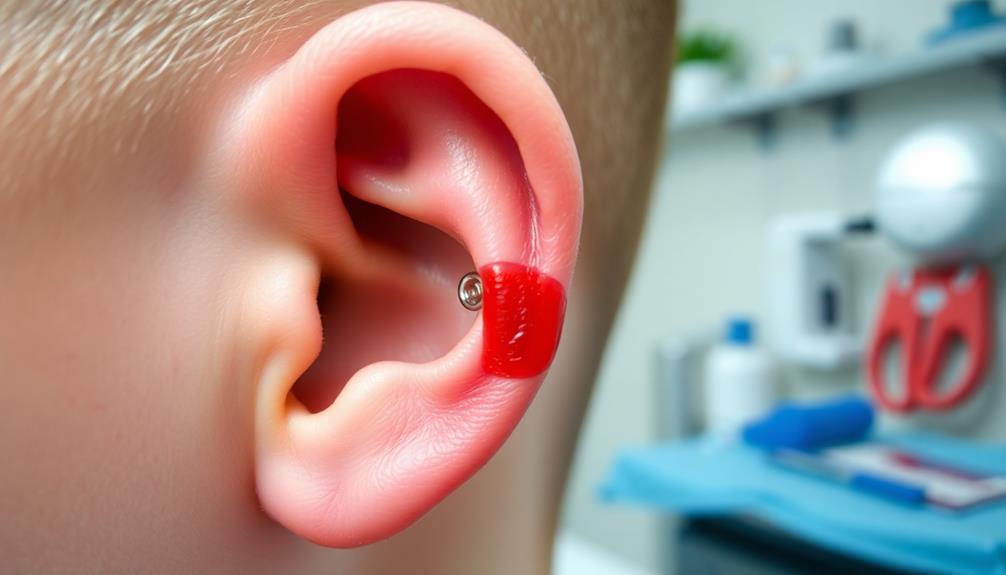Combining piercing and tattoos creates a unified body art that reflects your personal style and cultural roots. By thoughtfully pairing your tattoos with piercings, you enhance your features and tell meaningful stories. Skilled artists work together to guarantee harmony and balance, making sure each element complements the other. This integrated approach makes your body a living canvas, blending tradition and creativity. Keep exploring to discover how you can transform your body into a powerful expression of identity.
Key Takeaways
- Strategic placement of tattoos and piercings creates harmonious visual flow and emphasizes personal or cultural themes.
- Combining body art forms allows for a cohesive narrative that reflects individual identity and cultural significance.
- Skilled artists collaborate to design integrated pieces, ensuring aesthetic balance and meaningful symbolism.
- Placement and design synergy enhance overall impact, transforming body modifications into expressive, living artworks.
- Integration of tattoos and piercings deepens personal storytelling and cultural expression through unified visual storytelling.

Piercing and tattoos have evolved from rebellious expressions to celebrated forms of integrated art that reflect individuality and creativity. Today, they serve as powerful tools for personal storytelling and cultural symbolism, allowing you to showcase your identity in a visually compelling way. When exploring the world of piercing, you’ll discover a variety of piercing techniques designed to enhance both aesthetic appeal and comfort. From traditional ear piercings to more intricate body modifications, each technique is tailored to fit different styles and anatomical considerations. Skilled piercers use precise methods, such as the push, punch, or needle piercing techniques, to guarantee safety and minimize discomfort. Understanding these techniques helps you appreciate the craftsmanship behind each piercing, making it clear that this isn’t just about decoration—it’s an art form rooted in history and culture.
Piercing techniques blend artistry, safety, and cultural significance, transforming body modifications into meaningful expressions of identity.
As you choose your piercings, consider their cultural symbolism. Many cultures have used body modifications to signify social status, spiritual beliefs, or rites of passage. For instance, nose piercings in Indian culture symbolize marriage and prosperity, while ear piercings in African tribes often mark age or social roles. Incorporating symbols meaningful to your heritage or personal beliefs can deepen your connection to your body art, turning your piercing into a narrative of cultural identity. When combined with tattoos, these symbols can create a cohesive story that honors your background or personal journey. It’s this blend of cultural symbolism and artistic expression that transforms simple body modifications into powerful statements.
Integrating tattoos with piercings offers an exciting way to amplify your aesthetic and express your uniqueness. For example, a tattoo designed to complement a facial piercing can draw attention to your features or evoke a specific theme. You might choose a design that flows naturally around a piercing, creating a unified visual impact. The placement of both tattoos and piercings plays a vital role in achieving this harmony. Strategic positioning allows you to highlight certain elements or conceal others, depending on your mood or occasion. This thoughtful integration requires careful planning and collaboration with skilled artists and piercers who understand how to balance each element for maximum effect. Additionally, understanding piercing techniques can help you make informed decisions about placement and aftercare, ensuring your body art remains beautiful and healthy.
Ultimately, combining piercing and tattoos is about more than just looks; it’s about creating a personalized canvas that reflects your cultural roots, personal stories, and artistic vision. When you approach this integrated art with intention and knowledge of cultural symbolism and piercing techniques, your body becomes a living, breathing masterpiece. It’s an ongoing process of self-expression that celebrates both tradition and innovation, allowing you to stand out while honoring the rich histories behind these art forms. This fusion of body art empowers you to craft a unique narrative that’s unmistakably yours, transforming your body into a gallery of meaningful, integrated art.
Frequently Asked Questions
Can Piercing and Tattoo Healing Timelines Overlap Safely?
Yes, piercing and tattoo healing timelines can overlap safely if you follow proper care. During the healing process, you must keep both areas clean and avoid touching them to reduce infection risk. Wait until each healing process is well underway before combining activities that could cause irritation or delay healing. Consulting with a professional ensures you minimize infection risk and promote proper healing for both your piercing and tattoo.
Are There Specific Body Areas Better Suited for Combined Piercing and Tattooing?
You should choose body areas with lower skin sensitivity, like the upper arm or shoulder, for combined piercing and tattooing. These zones tend to heal faster and reduce discomfort. Avoid highly sensitive areas such as the ribs or inner wrists, which can be more prone to irritation and longer healing times. Picking suitable body areas helps guarantee both the piercing and tattoo heal properly while minimizing pain and complications.
How Do I Choose an Artist Skilled in Both Piercing and Tattooing?
Look for an artist whose artistic portfolio showcases both piercing and tattoo work, proving their versatility. Don’t just settle for claims; check their certification credentials to guarantee safety and professionalism. A skilled artist is worth their weight in gold—they truly know their craft inside and out. Ask for references or reviews, and trust your gut to find someone who can seamlessly blend piercing and tattooing into a unified art form.
Is There a Higher Risk of Infection With Combined Procedures?
Yes, combining piercing and tattooing can slightly increase your infection risk if hygiene precautions aren’t strictly adhered to. To minimize this, ensure your artist uses sterile equipment, wears gloves, and follows proper sanitation protocols. Good hygiene precautions are essential for both procedures, especially when done together. Always choose a reputable professional who prioritizes cleanliness to reduce any potential infection risks and ensure your safety during both treatments.
Can I Get a Tattoo Over a Fresh Piercing?
You shouldn’t get a tattoo over a fresh piercing. The healing piercing needs time to recover, and tattooing over it can cause infections and complicate healing. Consider your piercing placement and how it might affect tattoo design considerations, like placement and size. Waiting until your piercing is fully healed guarantees both the piercing and tattoo look their best, and reduces risks. Always consult a professional tattoo artist for personalized advice.
Conclusion
As you explore piercing and tattoos, you might find yourself unexpectedly drawn to their harmony, almost like they were meant to be together all along. It’s funny how a spontaneous decision can turn into a lifelong form of self-expression, blending art and identity seamlessly. When you realize how naturally they complement each other, it’s like fate guided your choices. Embrace this coincidence—your unique body art story is waiting to unfold, perfectly intertwined with your journey.
Piecing together a life one day at a time, that’s me. I’m Rusty, and I love being editor-in-chief of creative piercing. It’s my passion to help others see their vision and bring it to life. When I’m not working or taking care of my family, you can find me reading a good book or eating pie (of course!).

















